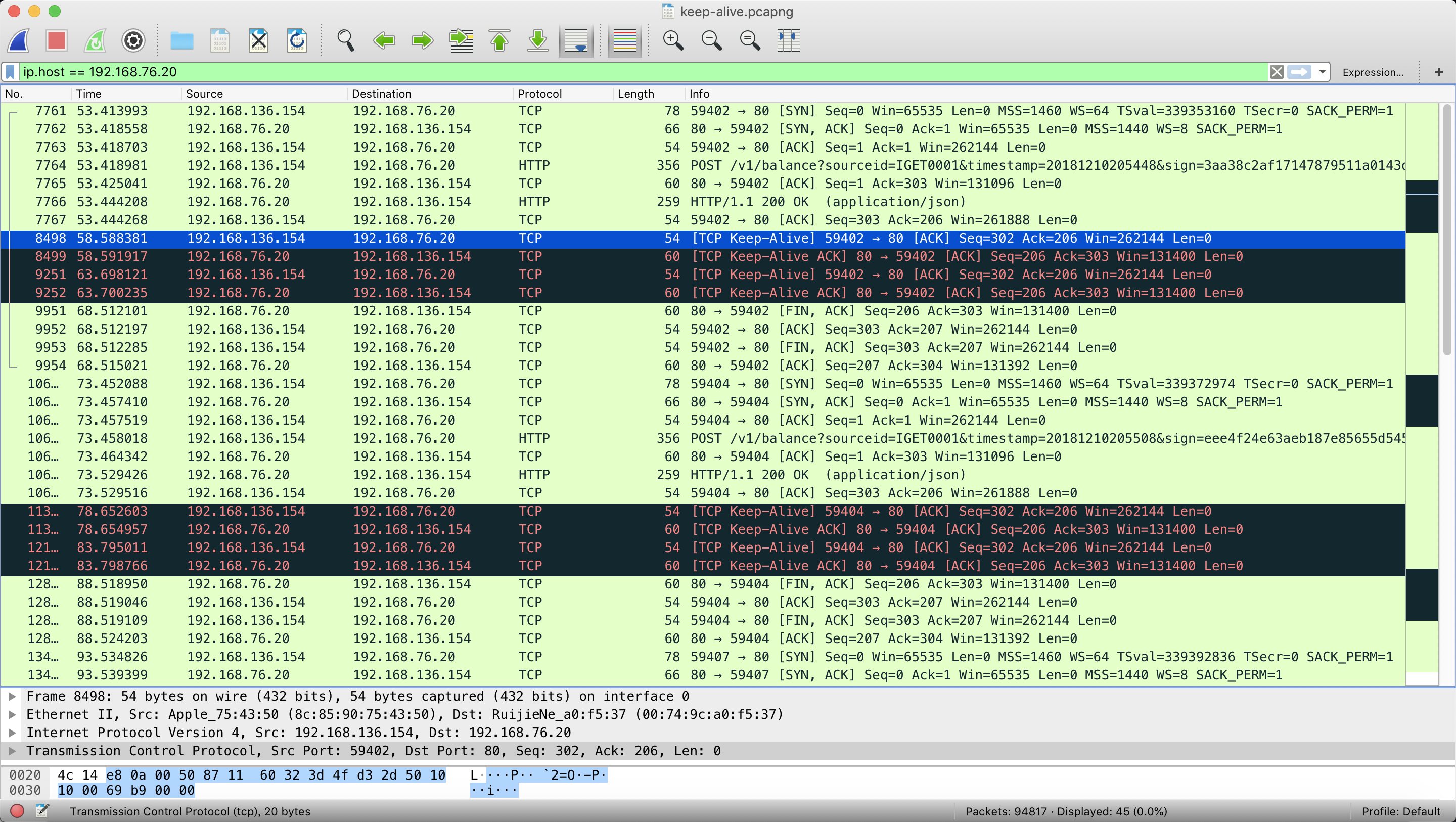Net Transport
版本 0.02
在调用第三方请求时,正确使用Client也不是一件非常容易的事。
下面是截取的一段描述,建议Client或Transport在整个服务期间最好是全局单例的,Transport本身会维护连接的状态,而且线程安全。强烈建议,不要使用系统提供的任何默认值。
The Client's Transport typically has internal state (cached TCP connections), so Clients should be reused instead of created as needed. Clients are safe for concurrent use by multiple goroutines.
Transport
如下是官方的简要描述。Transport字段在Client中被声明为接口类型,而实现这个接口的是Transport类型(略显绕)。在net包内部也提供了默认的实现变量:DefaultTransport。
// Transport specifies the mechanism by which individual
// HTTP requests are made.
// If nil, DefaultTransport is used.
Transport RoundTripper
看一下RoundTripper这个接口,官方描述:
RoundTripper is an interface representing the ability to execute a single HTTP transaction, obtaining the Response for a given Request.
既然是一个接口类型,我们就有理由自己去实现它,我们可以自定义自己的Transport。比如客户端发起一个请求,我们可以先去查询缓存中是否存在。如果存在,则将缓存中的数据写回response。如果不存在,请求远端服务获取数据,并缓存。
实现这样的功能,完全没有必要自定义一个Transport,我们也可以使用先请求缓存服务器,在请求远端服务器的方案来实现。但其实Transport就可以实现封装这些功能。
func cacheResponse(b []byte, r *http.Request) (*http.Response, error) {
//NewBuffer is intended to prepare a Buffer to read existing data.
buf := bytes.NewBuffer(b)
return http.ReadResponse(bufio.NewReader(buf), r)
}
官方提供了默认的Transport。如果不明确指定,那么底层就使用默认值。所以,可能连你也没有意识到,你在使用长链接。
另外:一定要记得当请求返回的error为空时,读取连接返回的数据,并明确调用Close关闭连接。否则连接会没法继续复用。
func (c *Client) transport() RoundTripper {
if c.Transport != nil {
return c.Transport
}
return DefaultTransport
}
缓存Idle连接
连接是如何被缓存的呢?怎么样唯一确定一个连接?缓存池的底层是什么?诸多问题,下面都会说到。首先解释如何从缓存池获取空闲连接:
//1. 获取的方法,截取其中一部分代码
func (t *Transport) getIdleConn(cm connectMethod) (pconn *persistConn, idleSince time.Time) {
key := cm.key()
t.idleMu.Lock()
defer t.idleMu.Unlock()
for {
pconns, ok := t.idleConn[key]
if !ok {
return nil, time.Time{}
}
if len(pconns) == 1 {
pconn = pconns[0]
delete(t.idleConn, key)
} else {
// 2 or more cached connections; use the most
// recently used one at the end.
pconn = pconns[len(pconns)-1]
t.idleConn[key] = pconns[:len(pconns)-1]
}
t.idleLRU.remove(pconn)
//省略之后的代码......
通过如下代码,可以确定net包通过当前请求的proxy URL、Scheme、Addr来缓存建立的连接。缓存的连接存储在一个MAP结构中: map[connectMethodKey][]*persistConn。map中的每一个Key对应了连接的slice数组,最新创建的连接会追加到slice的末尾。
func (cm *connectMethod) key() connectMethodKey {
proxyStr := ""
targetAddr := cm.targetAddr
if cm.proxyURL != nil {
proxyStr = cm.proxyURL.String()
if (cm.proxyURL.Scheme == "http" || cm.proxyURL.Scheme == "https") && cm.targetScheme == "http" {
targetAddr = ""
}
}
return connectMethodKey{
proxy: proxyStr,
scheme: cm.targetScheme,
addr: targetAddr,
}
}
因为Key中存在了Host地址,所以MaxIdleConnsPerHost这个值就显得格外重要。当准备缓存连接时,如果检测到当前的空闲连接数大于MaxIdleConnsPerHost,系统便会主动将这个连接关闭。这可能会是一个坑,特别要注意这一点。
如果不指定MaxIdleConnsPerHost,那么程序使用默认的值:DefaultMaxIdleConnsPerHost,这个默认值好比DefaultClient,都是问题所在。前者的默认值是2,可能直接导致在并发的时候,长链接的效率还不如短链接。后者的默认超时时间是0,这可能导致一个连接永远的挂在了那里。
使用net包提供的默认值,很多时候都不会是一件明智的事情。
func (t *Transport) tryPutIdleConn(pconn *persistConn) error {
//省略之前的代码......
if t.idleConn == nil {
t.idleConn = make(map[connectMethodKey][]*persistConn)
}
idles := t.idleConn[key]
if len(idles) >= t.maxIdleConnsPerHost() {
return errTooManyIdleHost
}
//省略之后的代码......
//主动关闭连接的代码
func (t *Transport) putOrCloseIdleConn(pconn *persistConn) {
if err := t.tryPutIdleConn(pconn); err != nil {
pconn.close(err)
}
}
客户端对每个主机最多可以保持Transport.MaxIdleConnsPerHost个长链接。对于长链接而言,一般是由服务端主动关闭的,而连接维持的时间也由服务端来决定。如果对于请求的域名,对应的Host足够多,在服务端关闭这些连接之前,可能会存在大量的空闲连接,造成资源浪费。
Test Case
下面是测试使用的例子,首先判断客户端和服务器之间是否支持长链接,然后通过抓包可以分析服务端长链接的持续时间。上文也阐述了,长链接一般是服务端主动断开连接,而这个时间的长短需要服务端自己决定。
首先我们声明一个Dialer用于创建连接。这里特别注意Dialer下的KeepAlive字段,这是Client为了维持长连接,主动发送TCP keep-alive segment的时间间隔,类比ping-pong模式。官方的解释是:KeepAlive specifies the keep-alive period for an active network connection. If zero, keep-alives are not enabled. Network protocols that do not support keep-alives ignore this field.。
我们在每次创建连接的时候,都将本地socket地址和服务端socket地址打印出来。如果没有新的地址生成,说明当前连接复用了前面创建的连接。这也侧面证明了是否服务端支持Keep-Alive。但需要强调的是,默认情况下只存在DefaultMaxIdleConnsPerHost个长连接。
func PrintLocalDial(ctx context.Context, network, addr string) (net.Conn, error) {
dial := net.Dialer{
Timeout: 30 * time.Second,
//指定的这个时间并没有生效,即使在请求完成后Sleep 30s连接仍然有效
KeepAlive: 5 * time.Second,
}
conn, err := dial.Dial(network, addr)
if err != nil {
return conn, err
}
fmt.Println("connect done, use ", conn.LocalAddr().String(), conn.RemoteAddr().String())
return conn, err
}
紧接着我们声明Client用于发送请求,Transport中使用上面声明的方法创建连接。并写测试用例用于测试。同时打开抓包工具,分析整个网络请求。
var client = &http.Client{
Transport: &http.Transport{
DialContext: PrintLocalDial,
},
}
func TestRequestBaiDu(t *testing.T) {
for i := 0; i < 3; i ++ {
resp, err := client.Get("http://xxxx.com")
if err != nil {
fmt.Println(err)
return
}
_, err = ioutil.ReadAll(resp.Body)
if err := resp.Body.Close(); err != nil {
fmt.Println(err)
}
time.Sleep(time.Second * 20)
}
}
通过截取到的请求可以得出:首先,client端每间隔5s发送keep-alive segment,其次,如果连接在15s内不活跃,服务端会关闭连接。通过分析图中的时间轴就可以得出。

TCP KeepAlive Timer
上图Wireshark抓取的数据报文中,那些红字体黑背景的报文给人一种貌似出错的感觉。而他本身就是TCP保活机制。在创建连接后,TCP两端都会启动一个Timer计时器,用于检测连接是否有效。
保活探测报文为一个空报文段(或只含有一个字节)它的序列号等于对方主机发送的ACK报文的最大的序列号减1,因为这一序列号的数据段已经被成功接受,所以不会对到达的报文段产生影响。
如图所示,第一个keep-alive segment的Seq=302,而它最近一次的Seq=303。这样整个保活过程都不会对data transfer产生影响。
下面便是设置keep-alive时间间隔的代码:
if tc, ok := c.(*TCPConn); ok && d.KeepAlive > 0 {
setKeepAlive(tc.fd, true)
setKeepAlivePeriod(tc.fd, d.KeepAlive)
testHookSetKeepAlive()
}
参考文章:
